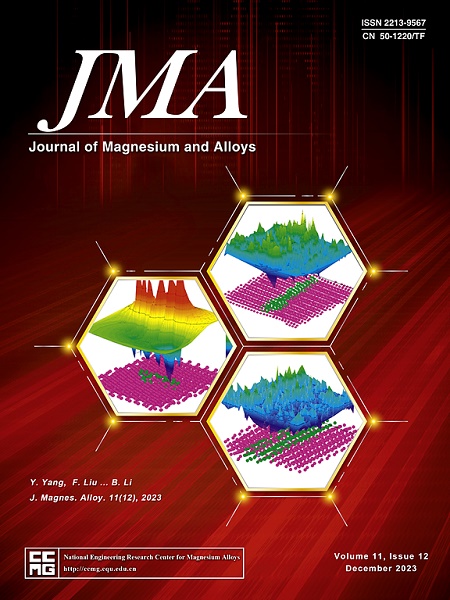Enhancing the creep resistance in a RE-free cast Mg-Al-Ca alloy through microalloying of Ti
IF 15.8
1区 材料科学
Q1 METALLURGY & METALLURGICAL ENGINEERING
引用次数: 0
Abstract
High temperature performance of magnesium alloys can be tailored by either grain size or precipitates in the grain interior. In this study, exceptional creep resistance was successfully acquired in a RE-free cast Mg-Al-Ca-Ti (AC51Ti) alloy. Microalloying of Ti (0.01 wt.%) has been found to be beneficial to the improvement of the tensile creep resistance in a RE-free cast Mg-5Al-0.35Mn-(1Ca) (AC51) alloy, showing a low state creep rate (SCR) of 2.70 × 10−9 s−1 at 200 °C/50 MPa, which is even better than that of many reported RE-containing Mg alloys. The presence of trace Ti contributes to the substantial refinement and more uniform distribution of Al2Ca precipitates in the matrix. At the same time, the microalloying of Ti improves the solubility of Al and Ca in the matrix. It is reasonable to believe that the microalloying of Ti induced re-organization of Al2Ca precipitates, dissolved a larger amount of Al and Ca atoms into magnesium lattice, and increased the possibility of interaction between GB/dislocations and precipitates, which strongly correlates with the high temperature properties. The creep strengthening mechanisms primarily attributed to both second phase strengthening and solid solution strengthening were separately proposed based on the experimental investigations.
通过钛微合金化增强无 RE 铸造镁铝钙合金的抗蠕变性
本文章由计算机程序翻译,如有差异,请以英文原文为准。
求助全文
约1分钟内获得全文
求助全文
来源期刊

Journal of Magnesium and Alloys
Engineering-Mechanics of Materials
CiteScore
20.20
自引率
14.80%
发文量
52
审稿时长
59 days
期刊介绍:
The Journal of Magnesium and Alloys serves as a global platform for both theoretical and experimental studies in magnesium science and engineering. It welcomes submissions investigating various scientific and engineering factors impacting the metallurgy, processing, microstructure, properties, and applications of magnesium and alloys. The journal covers all aspects of magnesium and alloy research, including raw materials, alloy casting, extrusion and deformation, corrosion and surface treatment, joining and machining, simulation and modeling, microstructure evolution and mechanical properties, new alloy development, magnesium-based composites, bio-materials and energy materials, applications, and recycling.
 求助内容:
求助内容: 应助结果提醒方式:
应助结果提醒方式:


